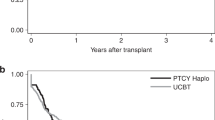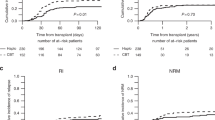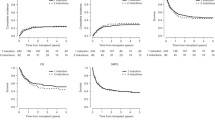Abstract
For patients with AML, the best alternative donor remains to be defined. We analyze outcomes of patients who underwent myeloablative umbilical cord blood or haploidentical hemopoietic stem cell transplantation (HSCT) in Spain. Fifty-one patients underwent single umbilical cord blood transplantation supported by a third party donor (Haplo-Cord) between 1999 and 2012, and 36 patients received an haploidentical HSCT with post-transplant cyclophosphamide (PTCY–haplo) between 2012 and 2014 in GETH centers. The Haplo-Cord cohort included a higher proportion of patients with high disease risk index and use of TBI in the conditioning regimen, and hematopoietic cell transplantation–age Comorbidity Age Index was higher in PTCY–haplo patients. Cumulative incidence of neutrophil engraftment was 97% in the Haplo-Cord and 100% in the PTCY–haplo group, achieved in a median of 12 and 17 days, respectively (P=0.01). Grade II–IV acute GvHD rate was significantly higher in the PTCY–haplo group (9.8% vs 29%, P=0.02) as well as chronic GvHD rates (20% vs 38%, P=0.03). With a median follow-up of 61 months for the Haplo-Cord group and 26 months for the PTCY–haplo cohort, overall survival at 2 years was 55% and 59% (P=0.66), event-free survival was 45% vs 56% (P=0.46), relapse rate was 27% vs 21% (P=0.79), and non-relapse mortality was 17% vs 23% (P=0.54), respectively. In this multicenter experience, Haplo-Cord and PTCY–haplo HSCT offer valid alternatives for patients with AML. Neutrophil engraftment was faster in the Haplo-Cord cohort, with similar survival rates, with higher GvHD rates after haploidentical HSCT.
This is a preview of subscription content, access via your institution
Access options
Subscribe to this journal
Receive 12 print issues and online access
$259.00 per year
only $21.58 per issue
Buy this article
- Purchase on Springer Link
- Instant access to full article PDF
Prices may be subject to local taxes which are calculated during checkout


Similar content being viewed by others
References
Ballen KK, Gluckman E, Broxmeyer HE . Umbilical cord blood transplantation: the first 25 years and beyond. Blood 2013; 122: 491–498.
Milano F, Gooley T, Wood B, Woolfrey A, Flowers ME, Doney K et al. Cord-blood transplantation in patients with minimal residual disease. N Engl J Med 2016; 375: 944–953.
Fernández MN, Regidor C, Cabrera R, García-Marco JA, Forés R, Sanjuán I et al. Unrelated umbilical cord blood transplants in adults: early recovery of neutrophils by supportive co-transplantation of a low number of highly purified peripheral blood CD34+ cells from an HLA-haploidentical donor. Exp Hematol 2003; 31: 535–544.
Liu H, Rich ES, Godley L, Odenike O, Joseph L, Marino S et al. Reduced-intensity conditioning with combined haploidentical and cord blood transplantation results in rapid engraftment, low GVHD, and durable remissions. Blood 2011; 118: 6438–6445.
Kwon M, Bautista G, Balsalobre P, Sánchez-Ortega I, Serrano D, Anguita J et al. Haplo-cord transplantation using CD34+ cells from a third-party donor to speed engraftment in high-risk patients with hematologic disorders. Biol Blood Marrow Transplant 2014; 20: 2015–2022.
Sebrango A, Vicuña I, de Laiglesia A, Millán I, Bautista G, Martín-Donaire T et al. Haematopoietic transplants combining a single unrelated cord blood unit and mobilized haematopoietic stem cells from an adult HLA-mismatched third party donor. Comparable results to transplants from HLA-identical related donors in adults with acute leukaemia and myelodysplastic syndromes. Best Pract Res Clin Haematol 2010; 23: 259–274.
Kwon M, Balsalobre P, Serrano D, Pérez Corral A, Buño I, Anguita J et al. Single cord blood combined with HLA-mismatched third party donor cells: comparable results to matched unrelated donor transplantation in high-risk patients with hematologic disorders. Biol Blood Marrow Transplant 2013; 19: 143–149.
Beatty PG, Clift RA, Mickelson EM, Nisperos BB, Flournoy N, Martin PJ et al. Marrow transplantation from related donors other than HLA-identical siblings. N Engl J Med 1985; 313: 765–771.
Ciceri F, Labopin M, Aversa F, Rowe JM, Bunjes D, Lewalle P et al. A survey of fully haploidentical hematopoietic stem cell transplantation in adults with high-risk acute leukemia: a risk factor analysis of outcomes for patients in remission at transplantation. Blood 2008; 112: 3574–3581.
Luznik L, O’Donnell PV, Symons HJ, Chen AR, Leffell MS, Zahurak M et al. HLA-haploidentical bone marrow transplantation for hematologic malignancies using nonmyeloablative conditioning and high-dose, posttransplantation cyclophosphamide. Biol Blood Marrow Transplant 2008; 14: 641–650.
Burroughs LM, O’Donnell PV, Sandmaier BM, Storer BE, Luznik L, Symons HJ et al. Comparison of outcomes of HLA-matched related, unrelated, or HLA-haploidentical related hematopoietic cell transplantation following nonmyeloablative conditioning for relapsed or refractory Hodgkin lymphoma. Biol Blood Marrow Transplant 2008; 14: 1279–1287.
Raiola A, Dominietto A, Varaldo R, Ghiso A, Galaverna F, Bramanti S et al. Unmanipulated haploidentical BMT following non-myeloablative conditioning and post-transplantation CY for advanced Hodgkin’s lymphoma. Bone Marrow Transplant 2014; 49: 190–194.
Brunstein CG, Fuchs EJ, Carter SL, Karanes C, Costa LJ, Wu J et al. Alternative donor transplantation after reduced intensity conditioning: results of parallel phase 2 trials using partially HLA-mismatched related bone marrow or unrelated double umbilical cord blood grafts. Blood 2011; 118: 282–288.
Bashey A, Zhang X, Sizemore CA, Manion K, Brown S, Holland HK et al. T-cell-replete HLA-haploidentical hematopoietic transplantation for hematologic malignancies using post-transplantation cyclophosphamide results in outcomes equivalent to those of contemporaneous HLA-matched related and unrelated donor transplantation. J Clin Oncol 2013; 31: 1310–1316.
Cheson BD, Bennett JM, Kopecky KJ, Büchner T, Willman CL, Estey EH et al. Revised recommendations of the International Working Group for Diagnosis, Standardization of Response Criteria, Treatment Outcomes, and Reporting Standards for Therapeutic Trials in Acute Myeloid Leukemia. J Clin Oncol 2003; 21: 4642–4649.
Armand P, Kim HT, Logan BR, Wang Z, Alyea EP, Kalaycio ME et al. Validation and refinement of the Disease Risk Index for allogeneic stem cell transplantation. Blood 2014; 123: 3664–3671.
Sorror ML, Storb RF, Sandmaier BM, Maziarz RT, Pulsipher MA, Maris MB et al. Comorbidity-age index: a clinical measure of biologic age before allogeneic hematopoietic cell transplantation. J Clin Oncol 2014; 32: 3249–3256.
Buño I, Nava P, Simón A, González-Rivera M, Jiménez JL, Balsalobre P et al. A comparison of fluorescent in situ hybridization and multiplex short tandem repeat polymerase chain reaction for quantifying chimerism after stem cell transplantation. Haematologica 2005; 90: 1373–1379.
Przepiorka D, Weisdorf D, Martin P, Klingemann HG, Beatty P, Hows J et al. 1994 Consensus conference on acute GVHD grading. Bone Marrow Transplant 1995; 15: 825–828.
Jagasia MH, Greinix HT, Arora M, Williams KM, Wolff D, Cowen EW et al. National Institutes of Health Consensus Development Project on Criteria for Clinical Trials in Chronic Graft-versus-Host Disease: I. the 2014 Diagnosis and Staging Working Group report. Biol Blood Marrow Transplant 2015; 21: 389–401.e1.
Gooley TA, Leisenring W, Crowley J, Storer BE . Estimation of failure probabilities in the presence of competing risks: new representations of old estimators. Stat Med 1999; 18: 695–706.
Bacigalupo A, Dominietto A, Ghiso A, Di Grazia C, Lamparelli T, Gualandi F et al. Unmanipulated haploidentical bone marrow transplantation and post-transplant cyclophosphamide for hematologic malignanices following a myeloablative conditioning: an update. Bone Marrow Transplant 2015; 50 (Suppl 2): S37–S39.
Dignan FL, Potter MN, Ethell ME, Taylor M, Lewis L, Brennan J et al. High readmission rates are associated with a significant economic burden and poor outcome in patients with grade III/IV acute GvHD. Clin Transplant 2013; 27: E56–E63.
Pidala J, Kurland B, Chai X, Majhail N, Weisdorf DJ, Pavletic S et al. Patient-reported quality of life is associated with severity of chronic graft-versus-host disease as measured by NIH criteria: report on baseline data from the Chronic GVHD Consortium. Blood 2011; 117: 4651–4657.
Vaughn JE, Gooley T, Maziarz RT, Pulsipher MA, Bhatia S, Maloney DG et al. Pre-transplant comorbidity burden and post-transplant chronic graft-versus-host disease. Br J Haematol 2015; 171: 411–416.
Acknowledgements
We thank the staff and nurses of all the hematology and transplant units for their care and contributions to making this work possible. We thank Jose Maria Bellón from the Instituto de Investigación Sanitaria Gregorio Marañon for data analysis. This work was partially supported by the Ministry of Economy and Competitiveness ISCIII-FIS grants PI08/1463, PI11/00708, PI14/01731 and RD12/0036/0061, co-financed by ERDF (FEDER) Funds from the European Commission, 'A way of making Europe', as well as grants from the Fundación LAIR, Asociación Madrileña de Hematología y Hemoterapia (AMHH) and Asociación Española Contra el Cáncer (AECC).
Author contributions
Conception and design: MK, GB, JG and PB.
Provision of study materials or patients: all authors.
Collection and assembly of data: MK, GB, JG and PB.
Data analysis and interpretation: all authors.
Manuscript writing: MK, GB and PB.
Final approval of the manuscript: all authors.
Author information
Authors and Affiliations
Consortia
Corresponding author
Ethics declarations
Competing interests
The authors declare no conflict of interest.
Rights and permissions
About this article
Cite this article
Kwon, M., Bautista, G., Balsalobre, P. et al. Haplo-Cord transplantation compared to haploidentical transplantation with post-transplant cyclophosphamide in patients with AML. Bone Marrow Transplant 52, 1138–1143 (2017). https://doi.org/10.1038/bmt.2017.36
Received:
Revised:
Accepted:
Published:
Issue Date:
DOI: https://doi.org/10.1038/bmt.2017.36
This article is cited by
-
Severe infections and infection-related mortality in a large series of haploidentical hematopoietic stem cell transplantation with post-transplant cyclophosphamide
Bone Marrow Transplantation (2021)
-
Post-transplant cyclophosphamide for GVHD prophylaxis compared to ATG-based prophylaxis in unrelated donor transplantation
Annals of Hematology (2021)
-
Secondary haploidentical hematopoietic stem cell transplantation in patients with relapse or graft failure after initial hematopoietic stem cell transplantation
Annals of Hematology (2019)
-
Against the odds: haplo-cord grafts protect from GvHD and relapse
Bone Marrow Transplantation (2017)



